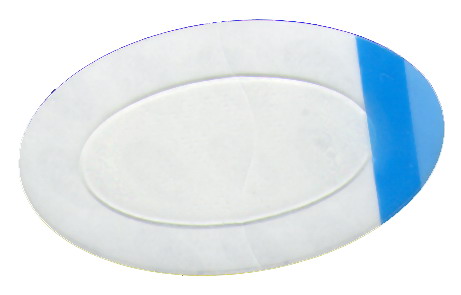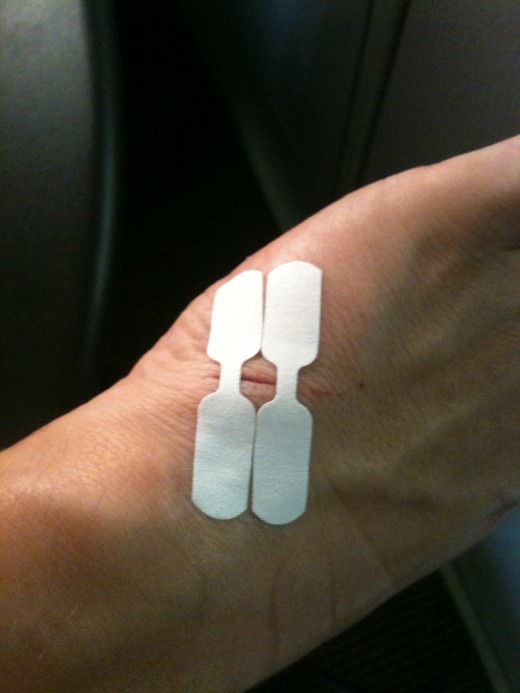Sticking plaster on:
[Wikipedia]
[Google]
[Amazon]
An adhesive bandage, also called a sticking plaster, medical plaster, or simply plaster in
 The backing and bag are often made of coated paper, but may be made of plastic.
The adhesive sheet is usually a woven fabric, plastic ( PVC,
The backing and bag are often made of coated paper, but may be made of plastic.
The adhesive sheet is usually a woven fabric, plastic ( PVC,

British English
British English (BrE, en-GB, or BE) is, according to Lexico, Oxford Dictionaries, "English language, English as used in Great Britain, as distinct from that used elsewhere". More narrowly, it can refer specifically to the English language in ...
, is a small medical dressing
A dressing is a sterile pad or compress applied to a wound to promote healing and protect the wound from further harm. A dressing is designed to be in direct contact with the wound, as distinguished from a bandage, which is most often used to hold ...
used for injuries not serious enough to require a full-size bandage
A bandage is a piece of material used either to support a medical device such as a dressing or splint, or on its own to provide support to or to restrict the movement of a part of the body. When used with a dressing, the dressing is applie ...
. They are also known by the genericized trademark
A generic trademark, also known as a genericized trademark or proprietary eponym, is a trademark or brand name that, because of its popularity or significance, has become the generic term for, or synonymous with, a general class of products ...
s of Band-Aid (as "band-aid" or "band aid" in Australia, Canada, India and the US) or Elastoplast
Elastoplast is a brand of adhesive bandages (also called ''sticking plasters'') and medical dressings made by Beiersdorf.
Background
In 1928 Smith & Nephew of the UK acquired the licence to market and produce the Elastoplast range of bandages.
...
(in the UK).
Function
The adhesive bandage protects the wound and scab from friction, bacteria, damage, and dirt. Thus, the healing process of the body is less disturbed. Some of the dressings haveantiseptic
An antiseptic (from Greek ἀντί ''anti'', "against" and σηπτικός ''sēptikos'', "putrefactive") is an antimicrobial substance or compound that is applied to living tissue/skin to reduce the possibility of infection, sepsis, or putre ...
properties. An additional function is to hold the two cut ends of the skin together to make the healing process faster.
Design
An adhesive bandage is a small, flexible sheet of material which is sticky on one side, with a smaller, non-sticky, absorbent pad stuck to the sticky side. The pad is placed against the wound, and overlapping edges of the sticky material are smoothed down so they stick to the surrounding skin. Adhesive bandages are generally packaged in a sealed, sterile bag, with a backing covering the sticky side; the backing is removed as the bandage is applied. They come in a variety of sizes and shapes.Materials
 The backing and bag are often made of coated paper, but may be made of plastic.
The adhesive sheet is usually a woven fabric, plastic ( PVC,
The backing and bag are often made of coated paper, but may be made of plastic.
The adhesive sheet is usually a woven fabric, plastic ( PVC, polyethylene
Polyethylene or polythene (abbreviated PE; IUPAC name polyethene or poly(methylene)) is the most commonly produced plastic. It is a polymer, primarily used for packaging ( plastic bags, plastic films, geomembranes and containers including b ...
or polyurethane
Polyurethane (; often abbreviated PUR and PU) refers to a class of polymers composed of organic units joined by carbamate (urethane) links. In contrast to other common polymers such as polyethylene and polystyrene, polyurethane is produced from ...
), or latex
Latex is an emulsion (stable dispersion) of polymer microparticles in water. Latexes are found in nature, but synthetic latexes are common as well.
In nature, latex is found as a milky fluid found in 10% of all flowering plants (angiosperms ...
strip. It may or may not be waterproof; if it is airtight, the bandage is an occlusive dressing. The adhesive is commonly an acrylate
Acrylates (IUPAC: prop-2-enoates) are the salts, esters, and conjugate bases of acrylic acid. The acrylate ion is the anion C H2=CHC OO−. Often, acrylate refers to esters of acrylic acid, the most common member being methyl acrylate. These acr ...
, including methacrylates Methacrylates are derivatives of methacrylic acid.
* Methyl methacrylate
* Ethyl methacrylate
* Butyl methacrylate
* Hydroxyethyl methacrylate
* Glycidyl methacrylate
Glycidyl methacrylate (GMA) is an ester of methacrylic acid and glycidol. Conta ...
and epoxy diacrylates (which are also known as vinyl resins).
The absorbent pad is often made of cotton
Cotton is a soft, fluffy staple fiber that grows in a boll, or protective case, around the seeds of the cotton plants of the genus '' Gossypium'' in the mallow family Malvaceae. The fiber is almost pure cellulose, and can contain minor pe ...
, and there is sometimes a thin, porous-polymer coating over the pad, to keep it from sticking to the wound. The pad may also be medicated with an antiseptic solution. In some bandages, the pad is made of a water-absorbing hydrogel. This is especially common in dressings used on blisters, as the gel acts as a cushion.
Some people have allergies
Allergies, also known as allergic diseases, refer a number of conditions caused by the hypersensitivity of the immune system to typically harmless substances in the environment. These diseases include hay fever, food allergies, atopic dermat ...
to some of these materials, particularly latex
Latex is an emulsion (stable dispersion) of polymer microparticles in water. Latexes are found in nature, but synthetic latexes are common as well.
In nature, latex is found as a milky fluid found in 10% of all flowering plants (angiosperms ...
and some adhesives.
Colors
Due to being widely available only in a standard color, some people with skin tones darker than the standard bandage color have expressed frustration at having to use bandages that looked less conspicuous on the skin of fairer-skinned people. This has led to greater support for pharmaceutical companies that manufacture these bandages in a variety of skin tones. Some bandages, especially those designed for children, may come in a wide variety of colors or may feature cartoon characters. Special bandages are used by food preparation workers. These are waterproof, have strong adhesive so they are less likely to fall off, and are usually blue so that they are more clearly visible in food. Some include a metal strip detectable by machines used in food manufacturing to ensure that food is free from foreign objects.Variants

Transdermal patch
A transdermal patch is a medicated adhesive patch that is placed on the skin to deliver a specific dose of medication through the skin and into the bloodstream. An advantage of a transdermal drug delivery route over other types of medica ...
es are adhesive bandages with the function to distribute medication through the skin, rather than protecting a wound.
Butterfly closures, also known as butterfly stitches, are generally thin adhesive strips which can be used to close small wounds. They are applied across the laceration in a manner which pulls the skin on either side of the wound together. They are not true sutures, but can often be used in addition to, or in place of actual sutures for small wounds. Butterfly stitches can be advantageous in that they do not need a medical professional to be placed or removed, and are thus a common item in first aid kit
A first aid kit or medical kit is a collection of supplies and equipment used to give immediate medical treatment, primarily to treat injuries and other mild or moderate medical conditions. There is a wide variation in the contents of first aid ...
s.
Notable brands
* Band-Aid *Curad
Medline Industries, LP is a private American healthcare company headquartered in Northfield, Illinois. In June, 2021 it was acquired by a consortium of private equity firms Blackstone, Carlyle and Hellman & Friedman valuing the company at $34 ...
* Elastoplast
Elastoplast is a brand of adhesive bandages (also called ''sticking plasters'') and medical dressings made by Beiersdorf.
Background
In 1928 Smith & Nephew of the UK acquired the licence to market and produce the Elastoplast range of bandages.
...
* Nexcare
See also
* Dressing (medical)References
External links
*{{commons category-inline, Adhesive bandages Medical dressings 20th-century inventions